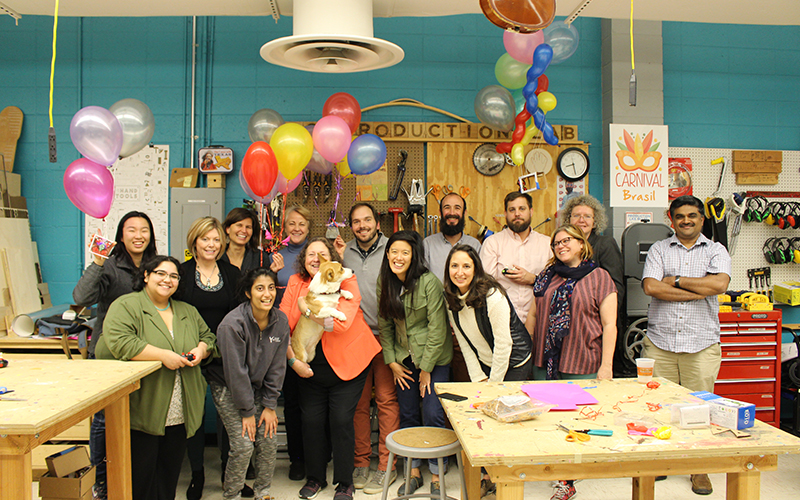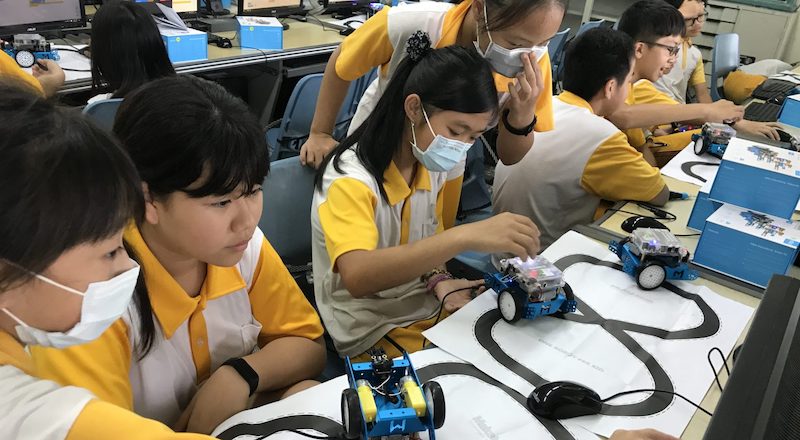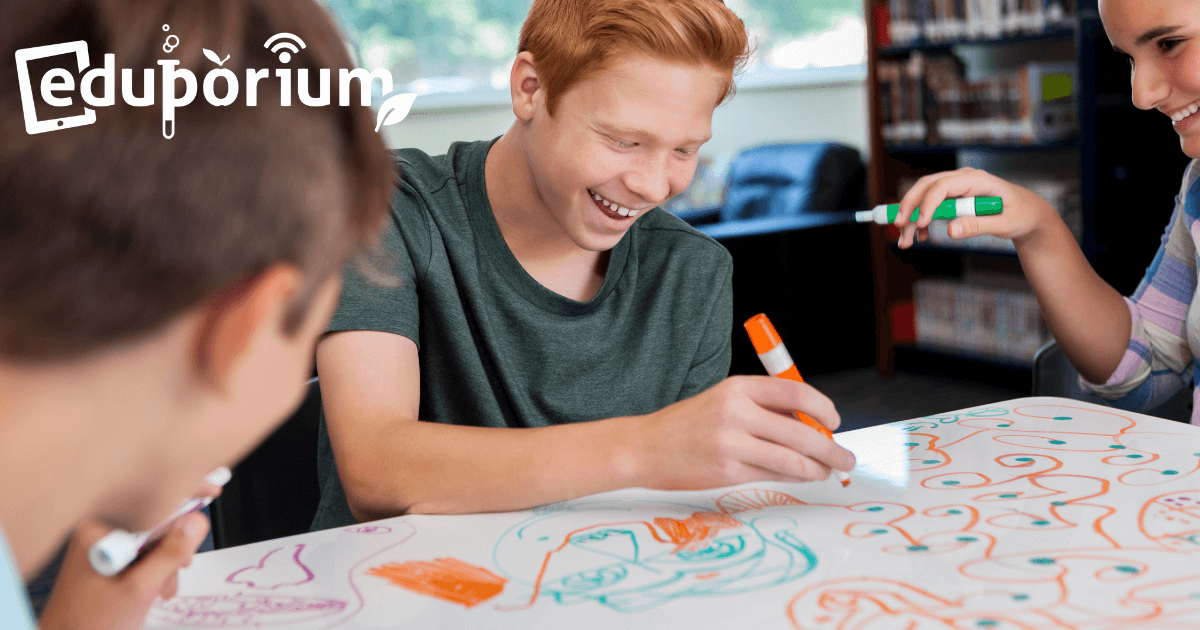What are some of the things you think of when you think of maker education? MakerEd includes everything from informal constructive play using everyday objects, glue, and tape to large-scale 3D printing and digital fabrication. Modern school makerspaces and fab labs have become the places to be for creative-minded students to showcase their making talents and thousands of schools have responded by building in-house areas for making. As maker education continues to evolve, so too do the tools, the mindsets, and even the finished products students are creating. So, what makes modern maker education such a powerful force in K-12 education and beyond?
Maker Education For All Ages
The simple act of engaging in maker learning offers immediate benefits to students in some continuously rewarding ways. Almost by default, the making process stirs the imaginations of students and helps them transform from consumers to creators. When they’re making, kids bring life to products and concepts that were formerly just ideas in their minds. One of the biggest reasons that maker education is so popular and prevalent is because of its connection to STEAM learning. Students of all ages tend to take as much STEM as they can get and the tinkering, crafting, collaborating, and problem solving that come along with maker education helps them achieve just that.
Knowing some facts about maker education helps teachers see it as something they can integrate in every grade level. Early elementary learners might be using low-tech tools while high school and college students are able to use powerful machinery in their projects. Despite noticeable differences, these are actually both forms of making and both are very much beneficial for children in all different age groups. Maker education enables makers, whether they’re students or professionals, to bring their ideas from the makerspace to the market. The end goal of the Maker Movement is for the makers to profit in some way from their innovative design. When students realize this is possible, the potential of MakerEd gets that much more exciting.
As you may know, the chance to become a maker can start as early as first or second grade depending on the tools and programs students can access. Makerspaces offer some of the best opportunities for kids to start making but teachers can also incorporate the creative aspects of maker education into other subjects. If they're teaching students how to think like a maker, they'll enjoy these benefits this cutting-edge learning style provides. A maker mindset allows educators to better lead students of any age and empowers them to explore making themselves! Whether it’s formal in your school or not, the need for these skills and their real-world relevance are increasing.
Supporting Maker Education District Wide
To put it simply, an expansion of maker education in K-12 schools starts with commitment from teachers and principals. There’s no doubt that the Maker Movement has gained a lot of momentum in the last few years both in and out of education but, to successfully make it a regular part of the school day, everybody must be on board. We see all the time that when school leaders feel strongly enough about any concept or program becoming a part of the curriculum, implementation may originate at the district level and then into each school. We can say the same for maker education; it takes a strong determination and commitment to give students the everyday opportunity for making to be part of their educational experiences.
Bringing maker education into the classroom certainly requires effective teamwork and for teachers to have the right mindset. In fact, the right mindset is probably even more important than having the physical space to allow for making. The essence of maker education lies in teachers empowering kids to create something meaningful and then observe the impact their work has on everything and everyone around them. To create these conditions, teachers can work with students and promote reflection, creativity, collaboration, and risk taking in making. As for methods, teachers need support from administrators to try new approaches, which create a correlation between making and standards. You can do this by infusing problem solving, tinkering, and more into staff meetings so teachers can get a feel for the experiences of their students.
Successful initiatives might require teachers to attend the same PD. This gets everybody on the same page and gives educators ideas for creating and sharing new makerspace projects. PD can even happen at local colleges so that all MakerEd teachers can visualize larger-scale making. Finally, instituting profitable maker programs requires leadership at each individual school following the district-wide learning. Administrators could look into bringing on a TOSA (teacher on special assignment) to help guide educators and students through making. Once that’s taken care of and teachers are ready to start making in the classroom, they’ll have to pay careful attention, make keen observations, and bring everything they learn back to the district leaders to fine tune it for the following school year. Piece of cake, right?

Taking MakerEd Further with Coding
Maker education creates innovative learning opportunities that help kids build skills that are useful for the future. Now, educators are realizing that makerspaces are the perfect place to help students build another crucial skill—coding. Since they’re open-ended, students can combine making and coding by adding this crucial element to objects and devices they build. So, now, they’re can still craft DIY devices but it’s more common for kids to then control crafts with coding. Any EdTech tool that combines making, engineering, technology, and coding is something you want to add to your makerspace.
Makerspaces are perfect places for students of any ages to combine physical building with basic coding so that they get the best of both worlds within an educational environment. Plus, most of the technology tools come with guided projects for kids to complete right within their makerspace. And, if they don’t, we probably have an activity you can download on our website! Even though products that combine making and coding tend to take longer since kids are generally building the projects from scratch, the process is much more involved. And, they’ll learn they can build physical objects and then, using simple technology, program them to do what they want.
Another reason making and coding go well together is due to the variety of objects students could control with code. They can control anything from robots to LED’s due to the flexibility of STEAM kits that are built for this. If you want an awesome maker experience, for example, try finding a kit with circuitry components, like breadboards, that kids can manipulate using code. Making with tools like this also affords kids with the chance to work with things like light and temperature sensors and sound triggers, which are great for them to know how to control. In some cases, students may need to download coding software, but generally in the earlier grades, all they need is what comes in the box and they’re ready for combining two of the most important areas of modern learning into an interactive experience.
Crafting Professional Development for Maker Educators
In order to provide meaningful maker education that will help prepare children for the future, those leading this learning need to know what to do and how to do it. A good place to start is transforming libraries into active makerspaces but that requires training teachers and them putting in a lot of time as well as learning how to alter their teaching styles to supplement this kind of learning. Once they know how to leverage the maker technology, use the makerspace to their advantage, and facilitate collaborative projects, educators can teach things to students that the curriculum often cannot. PD could help educators learn to teach 21st century kids but maker-focused PD also helps them learn to teach problem solving, working within groups, dealing with failure, and leadership.
First and foremost, maker educators must understand that adding making to their curriculum provides context for what it’s like to solve real-world problems with a creative process. It’s also important that they lead productive making, especially as students get older. While it may be fun for students to design shiny projects, this doesn’t translate to real-world learning. Ideally, teachers should aim to have all makerspace projects create learning across multiple disciplines. If they can highlight science and English concepts in makerspace projects, for example, that's a valuable use of time. Essentially, teachers should understand that students must get something from the making process and they must help create that meaning.
MakerEd PD should focus a lot on the making process, highlight creativity, facilitate hands-on learning, and include reflection. At the same time, teachers should begin to realize that there are various ways to connect making to other subjects. When they do this well, they can pass the knowledge on to students and lead by example in the makerspace. As far as PD activities go, something good to include in the sessions is getting familiar with maker lingo, like invention literacy, design thinking, and tinkering, for example. Educators also benefit from playing with maker tools themselves, a form of PD we’ve known to be very successful. Finally, teachers can finish up by creating some makerspace lesson plans. These could highlight the important PD concepts so they can see the results of their work in action.

MakerEd Helps Make Learning Fun Again
Raise your hand if you went through school with the mindset that anything involving learning wasn't going to be fun. That’s, unfortunately, how a lot of today’s students still feel. From a young age, children begin to associate school with work (often meaningless work) and work with boredom or frustration. So, naturally, it doesn’t take long for them to associate school with boredom and/or frustration. Maker education, however, can revamp feelings students have toward their education— in mostly positive ways. With opportunities to shake things up and make things personal, MakerEd can affect many students, teachers, and even school culture. All it takes is a little bit of an open mind and a lot can go right when embracing MakerEd.
One reason maker education is so popular with students is that it no longer limits them to their classroom. They can take learning into the hallways, the library, the playground, or all the way home. In fact, educators should emphasize the mobility of MakerEd, stressing that students don't need to complete projects only in classrooms. Often, they can focus more in new environments and their home environment can prompt new ideas and exploration. This is true for teachers, too. They don’t need to take hours coming up with perfect makerspace lesson plans. Go home—walk outside, even—and let your creativity take over! The more ideas teachers can come up with outside the classroom, the more inspiration they will have inside the classroom. This is because, most likely, they’ll enjoy the brainstorming more since it’s not as associated with work.
Above all else, MakerEd is about eliminating the fears of failure and trying new things. It empowers kids to pursue things they genuinely want to create—not something a decades-old curriculum dictates they must master. Whether makerspace learning takes place during school or after school, every teacher should try introducing it to students. There’s no telling how valuable this time for open-ended tinkering and discovery is for kids who learn in different ways. It could lead to a new invention or discovering a love for prototyping a student never knew they had. All it takes is the commitment to making learning fun and a few attention-grabbing activities for authentic and enjoyable learning.
For the latest EdTech, STEM, and 21st century education news, follow us on Twitter and Instagram. Like us on Facebook, too, or sign up for our newsletter for our latest product announcements and offerings. If you have an idea for an Eduporium Weekly theme, send us a message on social media or comment below.



